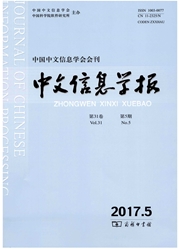

 中文摘要:
中文摘要:
文中首次涉及藏语的自然对话风格大词汇电话连续语音识别问题.作为一种少数民族语言,藏语识别面临的最大的困难是数据稀疏问题.文中在基于深层神经网络(DNN)的声学模型建模中,针对数据稀疏的问题,提出采用大语种数据训练好的DNN作为目标模型的初始网络进行模型优化的策略.另外,由于藏语语音学的研究很不完善,人工生成决策树问题集的方式并不可行.针对该问题,文中利用数据驱动的方式自动生成决策树问题集,对三音子隐马尔可夫模型(HMM)进行状态绑定,从而减少需要估计的模型参数.在测试集上,基于混合高斯模型(GMM)声学建模的藏字识别率为30.86%.在基于DNN的声学模型建模中,采用三种大语种数据训练好的DNN网络作为初始网络,并在测试集上验证该方法的有效性,藏字识别正确率达到43.26%.
 英文摘要:
英文摘要:
Large vocabulary continuous speech recognition on telephonic conversational Tibetan is firstly addressed in this paper. As a minority language , the major difficulty in Tibetan speech recognition is data deficiency. In this paper, the acoustic model of Tibetan is trained based on deep neural networks (DNN). To address the issue of data deficiencies, the DNN models of other majority languages are used as the initial networks of the objective Tibetan DNN model. In addition, phonetic questions of Tibetan generated by phonetic expert are unavailable due to the lacking knowledge of phonetics. To reduce the number of tri-phone hidden Markov models (HMM) in Tibetan speech recognition, phonetic questions automatically generated in the data driven manner are used for tying the tri-phone HMM. In this paper, different clustering of tri-phone states is tested and the words accuracy is about 30. 86% on the test corpus by Gaussian mixture model (GMM). When the acoustic model is trained based on DNN, 3 kinds of DNN model trained by different large corpus are adopted. The experimental results show that the proposed methods can improve the reeogn/tion performance, and the words accuracy is about 43.26% on the test corpus.
 同期刊论文项目
同期刊论文项目
 同项目期刊论文
同项目期刊论文
 期刊信息
期刊信息
